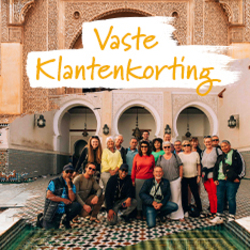Profiteer t/m 1 augustus
BekijkActivities
- Culture
- Cultural Wonders
- Natural Wonders
- Spot mysterious geishas in Kyoto's Gion district. Experience cherry blossom season or beautiful autumn colours. Take the incredible high speed 'bullet train'Explore temples in Kyoto and discover futuristic Tokyo
Food
-
1
Start Kyoto
The trip starts in Kyoto, an atmospheric city set amidst beautiful hills.
-
2
Visit Kinkakuji (Golden Pavilion), Ryoanji temple and Nijo castle; followed by Nishiki Market and historic Gion
With over 2000 temples, shrines and gardens, Kyoto is a treasure house of Japan's cultural heritage and remains undoubtedly one of the most fascinating cities in Asia. Unlike many other Japanese towns, it escaped the ravages of both the Second World War and modern urban development, thereby keeping intact much of the spirit and architecture of traditional Japan.Today, we have an introductory tour of the city. Starting with a visit to the famous Golden Temple of Kinkakuji, built in 1397 as a summer villa for the shogun Yoshimitsu Ashikaga and immortalised in Mishima Yukio's novel, 'The Golden Pavilion'. We then visit the Ryoanji temple, home to Japan's most famous and iconic rock garden, before moving onto the impressive Nijo castle, built in 1603 as a residence for the Tokugawa shoguns.At lunch we will head back to central Kyoto for a stroll at the famous Nishiki Market, known as 'Kyoto's Kitchen', which specialises in all things food related and is a great place to find seasonal foods and Kyoto specialties, such as Japanese sweets, pickles, dried seafood and sushi. Those who wish may opt to take a leisurely lunch at one of the local restaurants in the area or rest at the hotel.Later in the afternoon, we will have the opportunity to walk around historic Gion, Kyoto's most famous geisha district. Packed with bars, restaurants and traditional teahouses, Gion is at its most atmospheric in the early evening, when the lanterns are lit and apprentice geisha will flit about the back streets on their way to their appointments.
-
3
Day trip to Nara, ancient capital of Japan. Visit impressive UNESCO temples including Toda-ji, housing the world's largest bronze statue of the Buddha
Today we make a day trip to Japan's ancient capital, Nara (approx. 1hr each way). With eight UNESCO World Heritage Sites, it's second only to Kyoto as a repository of Japan's cultural legacy. Our walking tour includes a visit to the most iconic temples and shrines, including the Todaiji Great Buddha temple. Built in 752 by the Emperor Shomu this enormous 15 meter tall bronze Buddha is housed in what is reputed to be the largest wooden building in the world. We also spend time in the Nara Koen park, famous for its large numbers of overfed and slightly unruly deer, and visit the attractive Kasuga Shinto shrine, before returning to Kyoto in the late afternoon.
-
4
Free day in Kyoto; relax in one of the many zen gardens, walk the popular Philosopher Path or experience a traditional tea ceremony
Today is a free day for individual sightseeing. With so much to see and do in Kyoto it can be difficult to know where to begin. Our advice is to start with a very early visit to Fushimi Inari Shrine, Kyoto's most important Shinto shrine and famous for its thousands of vermilion torii gates, which straddle a network of trails behind its main buildings. Getting there before the crowds at sunrise is the secret for a magical experience.The rest of the day could be spent exploring one of the several well established and easy-to-follow walking tours that take in many interesting sights. The eastern part of Kyoto is particularly rich in temples and gardens, and one can spend the day in this area, perhaps strolling along the tree-lined canal known as the Philosophers' Path and taking time out for contemplation in one of the many intriguing Zen gardens that dot the hillsides.Another day-trip to consider would be to Arashiyama, a pleasant tourist district in the western outskirts of Kyoto. The area has been a popular destination since the Heian Period (794-1185), when nobles would enjoy its natural setting. Arashiyama is particularly popular during the cherry blossom and autumn colour seasons.If you are interested in Japanese arts and cultural activities, there is also the option of visiting a cultural show to see some of Japan's ancient traditions such as the tea ceremony and Japanese theatre (these can be arranged locally by your tour leader and subject to availability).
-
5
Day trip to Hiroshima; visit Peace Memorial Park and the pretty island of Miyajima
Today is our first experience of Japan's shinkansen (bullet train) as we speed our way to Hiroshima for the day (approx. 2hrs each way). Once in Hiroshima, we make a short excursion by local tram and ferry to the beautiful island of Miyajima; famous for the 'floating' tori (Shinto gate) of the Itsukushima-jinja Shrine. At high tide, when set against the backdrop of Mt Misen, this tori makes for one of the most beautiful and photogenic sights in Japan. Please note, whilst the ‘floating’ tori of Itsukushima-jinja Shrine is currently undergoing renovation works, we still recommend a visit to this enchanting island as part of the day trip to Hiroshima.In the afternoon we spend time at the A-Bomb museum and the Peace Memorial Park in Hiroshima, both monuments to the fateful day in August 1945 when the city was selected as the target for the world's first wartime use of the atomic bomb. In the park burns a symbolic flame that will only be extinguished when the last nuclear weapon on earth has been destroyed. We depart Hiroshima late afternoon arriving back at our hotel in Kyoto in the evening.
-
6
Travel from Kyoto to Takayama, a traditional old town set amid the 'Japanese Alps'; visit the Hida Folk Village
Travelling by train through forested valleys we make our way this morning to the peaceful and attractive old town of Takayama (approx. 4 hrs) nestling sleepily in the centre of the majestic Hida Mountains. We spend two nights here and have plenty of time to appreciate the charm and ambience of this delightful place. In the afternoon we visit the Hida Folk Village, an interesting outdoor museum of traditional rural architecture set in pleasant landscaped gardens, located a short walk from our accommodation. We stay in a traditional Japanese style accommodation where we have the opportunity to experience the Japanese lifestyle and hospitality (please refer to the accommodation section for more information).
-
7
Orientation tour in Takayama and free day to explore its peaceful shrines and temples
With over a dozen museums and galleries to suit all interests and several well-kept temples and parks, there are plenty of ways to spend a relaxing day in Takayama. We start with a short orientation tour around the morning market held daily along the banks of the Miyagawa River in the centre of town. Here amidst the friendly farmers with their familiar, and not so familiar, agricultural produce it is also possible to find some interesting souvenirs. Not so far away and of particular interest is the well-preserved collection of streets known as Sannomachi, where the many wooden built shops, restaurants and sake breweries give the area a mediaeval feel. For an insight into the life of medieval Japanese officials and the way they dealt (often not so compassionately) with those in their charge, a visit to the old Government House of Takayama-jinya is recommended. The remainder of the day is free to explore the town at your own pace: we recommend taking a stroll along the temple-line path called the Higashiyama Walkway and visit the several temples and attractions created by the mediaeval warlord, Kanamori Nagachika (1524-1600), who longed for Kyoto.
-
8
On to the mediaeval village of Tsumago; short leisurely walk on the Nakasendo trail; train to Matsumoto
Today we travel by express and local trains to the historic castle town of Matsumoto (approx. 4hrs). Enroute, we visit the mediaeval village of Tsumago that has changed little from its heyday as a post town in the Edo period. This is the best preserved of the many staging posts along the old Nakasendo Way, which fulfils the same role it did in centuries past - offering food and refuge to travellers. Those who wish can join the leader for an optional 1hr walk through peaceful forest trails, starting by the Odaki and Medaki waterfalls and finishing in Tsumago. We reach Matsumoto late afternoon where we have time to relax and perhaps take a leisurely stroll after dinner to see the impressive castle by night.
-
9
Visit the famous Matsumoto Castle and travel by train to spa town of Yudanaka; soak in a hot spring
This morning we visit the impressive Matsumoto castle. Founded in 1504, this castle, otherwise known as Crow Castle due to its black colour, is one of the two best preserved in Japan, most others having been destroyed following the Meiji Restoration. Its imposing six story donjon has been designated a national treasure. Please note that the castle preserves its original interior and structure, with very tall steps and steep staircases which some might find difficult to ascend and descend. We return to Matsumoto train station for our afternoon journey (approx. 3hrs) to the relaxing spa town of Yudanaka, which boasts some fantastic natural hot springs, where we spend a night in another Japanese-style accommodation.
-
10
See the famous Snow Monkeys before travelling by train to Tokyo; evening orientation tour
As well as being home to some of Japan's best hot springs, the small spa-town of Yudanaka is mainly famous for being the gateway to the famous Jigokudani Onsen or 'Snow Monkey Park'. Here, the indigenous macaque monkeys have discovered the benefits of descending from the hills to soak and play in hot baths - observing their behaviour up close is fascinating! This is the only tribe of monkeys anywhere in the world to bath in hot springs for warmth. The sight is most spectacular in winter, when snow covers the grounds and the hot steam creates some amazing visual effects but despite the name, the so called 'snow monkeys' actually inhabit the area year-round. To reach the park we walk for approx. 20-25 mins on an easy forest trail and we will have approx. 1hr free to admire and photograph these entertaining creatures.No visit to Japan would be complete without a trip to Tokyo. This afternoon, we travel from Yudanaka to the capital by bullet train (approx. 4hrs), arriving in the early evening. On arrival in Tokyo we'll transfer to our hotel and start exploring the bright lights of the big city at night.
-
11
Optional trip to Hakone and Mount Fuji or to the lovely seaside town of Kamakura
For those wishing to see still more of this wonderful country, today is the last day of your Japan Rail Pass, entitling you to free train journeys to many destinations. One popular day-trip amongst tourists and Japanese alike looking for a break from Tokyo is Hakone, part of the Fuji-Hakone-Izu National Park, less than 1hr and 30 mins by train. Famous for hot springs, natural beauty and the view of nearby Mt. Fuji, Hakone area also encompasses Lake Ashi, which can be toured by boat.Another alternative blissful escape from the city is the coastal town of Kamakura, offering numerous temples, shrines, historical monuments as well as panoramic hiking trails.For those not wishing to leave Tokyo, this day is free to soak up the atmosphere of this truly astounding city. Whilst being perhaps the most energetic and futuristic city in the world, for a capital, Tokyo still remains a remarkably friendly, safe, manageable and delightful place to visit.
-
12
A full day city tour of Tokyo including the Senso-ji Temple
Today we have a guided tour of Tokyo. Making use of the city's highly efficient tube system we can visit some of Tokyo's main attractions including Ueno (depending on season) and the lively Senso-ji Temple in the old entertainment district of Asakusa. We will also visit one of the city's parks or gardens which become especially spectacular during cherry blossom and autumn season. There is also some free time to discover other attractions at your own pace. For those with a head for heights we recommend an optional visit to the iconic Skytree Tower for breathtaking views of the city. With a height of 634 meters, it is the tallest building in Japan and the second tallest structure in the world at the time of its completion. In the evening, the possibilities for entertainment are almost limitless with Tokyo's nightlife as exciting as anywhere in Asia.
-
13
Free day for further exploration; optional karaoke farewell night
Today has been left free for further individual exploration of Tokyo. Worth visiting is the Meiji Shrine; surrounded by tranquil forest, this Shinto shrine is one of the most popular in Japan and combines traditional Japanese architecture with love for the nature. Or for those interested in culture or shopping, there are limitless opportunities with districts like Ginza, Harajuku and Shinjuku catering for all tastes and needs! Your leader will be on hand to advise how best to maximise your free day in Tokyo.
-
14
End Tokyo
The tour ends this morning for land only client. Clients who are booked on the group flights to London will be transferred to Tokyo Narita Airport in the evening. If you are not travelling on the group flight, it is possible to have a free shuttle service departure transfer to Narita or Haneda Airports. Please contact our Operations team for more information or to request this. Please note, the free shared shuttle departure transfer must be requested in advance with Exodus before departure if you wish to utilise this service (all requests are subject to availability and must be confirmed before departure). It is not possible to request this service once a trip has commenced.






























